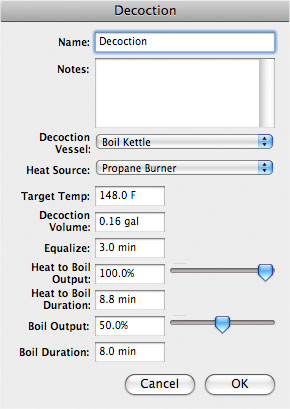Decoction: Difference between revisions
mNo edit summary |
|||
| Line 17: | Line 17: | ||
* [[Fly sparge]] | * [[Fly sparge]] | ||
* [[Batch sparge]] | * [[Batch sparge]] | ||
This is a technique developed by old style European brewers for brewing lager beers. Mostly used on undermodified malts that can't fully convert the starches to sugars. Boiling the grains for a short time, 10 mins. will reduce the size and complexity of malt starch and protein molecules and make them more convertable into sugars for the yeast to eat, and make a clearer beer. It will also raise your effiency. It will give the beer slightly more color, and a deeper malt flavor, creating a compound called melonoidin. Think of searing a steak on a grill. With highly modified malts such as those in the U.S., only a protein rest and a single decoction 33-40% of the thick mash, with a raise to saccarification rest may be sufficient. After your protein rest pull the decoction amount and bring the malt up to saccarafication temp and hold for 15 min, then bring to boiling gently by stiring and 50% of your heat output to avoid scorching. You can use a strainer to pull out the thick malt, with only enough liquid to cover it. Note your data in the decoction box in BTP. | |||
Revision as of 14:40, 16 January 2007
Decoction is a way to raise mash temperature by removing a portion of the mash, heating it,and returning it to the mash vessel.
Editor
Notes
This is a technique developed by old style European brewers for brewing lager beers. Mostly used on undermodified malts that can't fully convert the starches to sugars. Boiling the grains for a short time, 10 mins. will reduce the size and complexity of malt starch and protein molecules and make them more convertable into sugars for the yeast to eat, and make a clearer beer. It will also raise your effiency. It will give the beer slightly more color, and a deeper malt flavor, creating a compound called melonoidin. Think of searing a steak on a grill. With highly modified malts such as those in the U.S., only a protein rest and a single decoction 33-40% of the thick mash, with a raise to saccarification rest may be sufficient. After your protein rest pull the decoction amount and bring the malt up to boiling gently by stiring and 50% of your heat output to avoid scorching. You can use a strainer to pull out the thick malt, with only enough liquid to cover it. Note your data in the decoction box in BTP.
See also
This is a technique developed by old style European brewers for brewing lager beers. Mostly used on undermodified malts that can't fully convert the starches to sugars. Boiling the grains for a short time, 10 mins. will reduce the size and complexity of malt starch and protein molecules and make them more convertable into sugars for the yeast to eat, and make a clearer beer. It will also raise your effiency. It will give the beer slightly more color, and a deeper malt flavor, creating a compound called melonoidin. Think of searing a steak on a grill. With highly modified malts such as those in the U.S., only a protein rest and a single decoction 33-40% of the thick mash, with a raise to saccarification rest may be sufficient. After your protein rest pull the decoction amount and bring the malt up to saccarafication temp and hold for 15 min, then bring to boiling gently by stiring and 50% of your heat output to avoid scorching. You can use a strainer to pull out the thick malt, with only enough liquid to cover it. Note your data in the decoction box in BTP.
